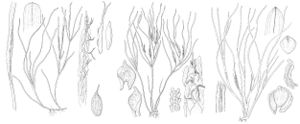Zostera marina
Sp. Pl. 2: 968. 1753.
Herbs, perennial. Rhizomes 2–6 mm thick; roots 5–20 at each node. Leaves: sheath tubular, rupturing with age, 5–20 cm, membranous flaps absent; blade to 110 cm × 2–12 mm, apex round-obtuse or slightly mucronate; veins 5–11. Generative shoots terminal, repeatedly branched, each branch with 1–5 spathes. Inflorescences: peduncles with adnate portion 15–100 mm, free portion 2–3 cm; spathes 10 or more, sheath 4–8 cm × 2–5 mm; blade 5–20 cm; spadix linear; staminate flowers 1–20; pistillate flowers 1–20, apex acute or mucronate. Staminate flowers: bracts absent or rarely 1 subtending most proximal flower; pollen sacs 4–5 × 1 mm. Pistillate flowers: ovary 2–3 mm, style 1–3 mm. Fruits ellipsoid to ovoid, 2–5 mm, often beaked.
Phenology: Flowering late spring–summer.
Habitat: Intertidal to sublittoral of marine waters
Elevation: -10–0 m
Distribution
B.C., N.B., Nfld. and Labr. (Nfld.), Nunavut, N.S., Ont., P.E.I., Que., Yukon, Alaska, Calif., Conn., Del., Maine, Md., Mass., N.H., N.Y., N.C., Oreg., R.I., Va., Wash., Mexico (Baja California, Sinaloa, Sonora), Eurasia.
Discussion
Zostera marina is adapted to the cold waters of the North Atlantic and North Pacific. It extends southward to North Carolina in the Atlantic and Baja California in the Pacific. At the southern limits of its range, active growth mostly is in the cooler months of autumn and spring, with flowering and fruiting mostly in the spring and the plants dying in the hotter summer months, the vegetation becoming dislodged from the substrate and floating to the water surface. The fruits apparently remain in the floating vegetation for a period of time, eventually falling from the shoots to the substrate. Movement in dislodged vegetative material is the only adaptation the fruits have for dispersal (C. den Hartog 1970).
The species is found mostly in the sublittoral region, only rarely being exposed at low tide. It occurs in more or less sheltered areas on soft mud or firm sand. Plants of sandy substrates had narrower leaves than plants growing on muddy substrates (C. H. Ostenfeld 1905). Fruits fall from the floating vegetation to the substrate and settle on the substrate ripple marks, which run more or less perpendicular to the direction of current. Seedling establishment is parallel with the ripple marks, forming vegetated ridges separated by depressions, which gradually fill with sediments, and the plants then grow laterally into them, forming a meadow (C. den Hartog 1970). The vegetation lowers the velocity of current flow, causing some suspended particles to settle out and accumulate around the base of the plants, slowly building the substrate. As more particles accumulate, the substrate gets deeper over the rhizomes, since the rhizomes grow horizontally, not vertically. Eventually, the rhizomes are too deep, and the plants begin to die back, a phenomenon followed by erosion.
